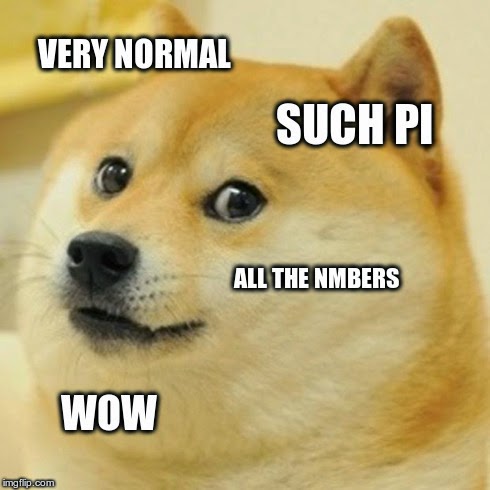Yes, I realize this
is a week late. Ilyen az élet
- I'm trying to finish up my PhD here and punctuality seems to be a
thing that happens to other people. Besides, the proper day to
celebrate is going to be June 28th
anyway.
One thing I saw
getting passed around for Pi-day last year (did I mention punctuality
was not my thing right now?) was this image below. While it is kind
of cute, it's also wrong. But it's wrong in some rather interesting
ways, so I thought it might be worth expanding on why.
 |
| From all over the interwebs |
While the image is
correct that the decimal representation of pi is infinite and
non-repeating, this does not imply* that all possible number
combinations are contained within it. In fact, it's pretty trivial to
come up with a number that doesn't to that: take the number
0.12112111211112111112.... for example. Or take pi and cross out
every digit that's a 7. Either way, we know you're never going to see
the number “79” somewhere in the pattern. So that's out.
But does pi contain
all possible number combinations? Well, that's a profound
“maaayyyybbbeeee?”, and here's where the story gets interesting.
A normal** number
is a number where all the digits and combinations thereof appear with
equal frequency if you look long enough. You should be able to find a
Feynman point
somewhere in there, as well as your pixel-perfect image of your
death, the script to Monty Python's Silly Walks sketch, and a number
that gives you a gzipped version of Corel WordPerfect 8 along with
other illegal numbers.
The great answers to everything is in there, as well as a far greater
multiplicity of wrong answers. And wrong questions.
Though, of course,
we shouldn't just talk about base-10. A number may be normal in one
base b (being called b-normal) and not in another. So we have an
extra definition; if a number is normal in all bases, then it is
called absolutely normal.
So, is pi 10-normal?
16-normal? Is it absolutely normal? Efforts to calculate the firstseveral trillion digits of pi
indicate that its digits are uniformly distributed, which is a good
sign. But that's not enough to really prove anything. The problem
with infinity is that's there's a lot of it, and so it's difficult to
really say that you won't start to run out of certain digit
sequences. Especially once you get to the sorts of digits positions
where regular numbers are insufficient to write out how far along you
are. We do not, in fact, know if pi is normal, or if it's absolutely
normal. Perhaps we won't find our Ministry of Silly Walks script in
there, nor some jpeg file of a Doge meme.
Normal numbers seem
like they'd be magically rare beasts but, as a matter of fact, almost
all real numbers are absolutely normal. This makes sense if you stop
and think about it—how would you go about picking a truly random
real number? Well, you might think about its decimal representation
(and let's just think about numbers between 0 and 1 for now). First,
randomly pick its first digits as one of 0 to 9. Then do the same for
the second digit, then the third, and so on and so on. But this same
way of trying to construct a real number would mean that all digits
and digit sequences ARE uniformly distributed throughout its decimal
representation, and would thus at least be 10-normal.
But just because
almost all numbers are absolutely normal this does not mean that it's
easy to prove that a specific number is. Outside of some numbers that
seem to “cheat” (like Champernowe's constant
0.12345678910111213...) and a few other examples, we just don't know.
And this is, really,
one of my favorite parts of math. There are so many proofs that say
“I know this thing exists and is overwhelmingly common. But damned
if I can give you more than a handful of nontrivial examples.” We
can see this with ultrafilters, with Hamel bases, or with trying to see
if some numbers are transcendental. I think it's so wonderfully
curious that out of the uncountable infinity of numbers we have, in a
sense we can only grasp at thin fraction of them. Heck, we can't even
DESCRIBEmost numbers in a non-infinite way.
I think pi*** would
be MORE special if they weren't normal in some way. Normal numbers
are, truly, normal****. Contra Carl Sagan's novel Contact,
it would be a far greater sight to find something that wasn't in pi
than something that is.
 |
| Perhaps something like this. |
*Mathematically,
it's necessary, but not sufficient.
**”Normal” is,
IMHO, one of the most overused adjectives in math, followed by
“regular”. Come on mathematicians, come up with some new phrases!
***Or tau, I'm not
conceding this fight.
****Still no excuse
for overusing the adjective.
No comments:
Post a Comment